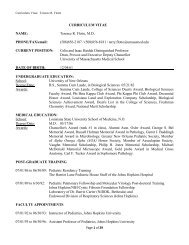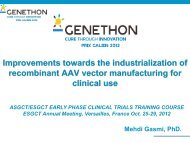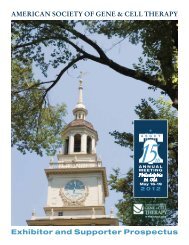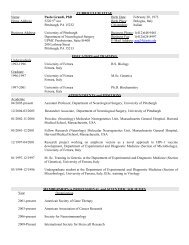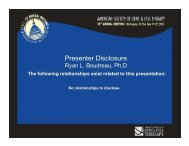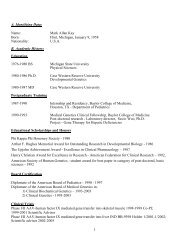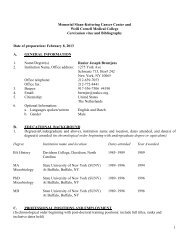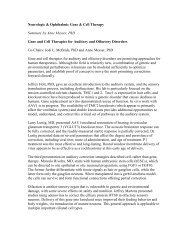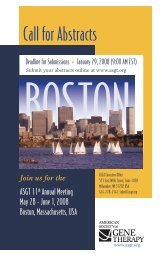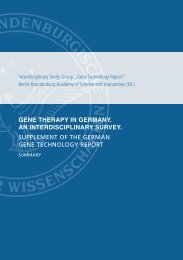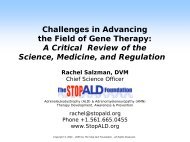13 th AnnUAL MEETing | Washington, DC USA May 19-22, 2010 33Program ScheduleEducation Session 1203:30 pm - 5:00 pmRoom: Virginia SuiteEmerging Field Review: Genomic Basis <strong>of</strong> Human DiseaseThis program will be presented by three established investigators at the NIH National Human Genome Research Institute and will highlight active research programs <strong>of</strong>direct relevance to the field <strong>of</strong> gene and cell based therapies. The topics to be covered include: 1) The Genomics Landscape Circa 2010, 2) The ClinSeq Project: PilotingGenome Sequencing for Research in Genomic, and 3) The NIH Undiagnosed Diseases Program.Wednesday, May 19 thChairPaul B. McCray, Jr., MDSpeakersEric D. Green, MD, PhDThe Genomics Landscape Circa 2010The Human Genome Project’s completion <strong>of</strong> the human genome sequence in 2003 was a scientific achievement <strong>of</strong> historic proportions. It also signified a critical transition,as this new foundation <strong>of</strong> genetic information started to be used in powerful ways by researchers and clinicians to tackle increasingly complex problems in biomedicine.Current efforts in genomics research are focused on using genomic data and technologies to acquire a deeper understanding <strong>of</strong> biology and to uncover the genetic basis <strong>of</strong>human disease. Together, these pursuits are moving us down an exciting path towards genomic medicine and fulfilling the promise <strong>of</strong> a sequenced human genome.Leslie G. Biesecker, MDLarge Scale Sequencing and Hypothesis-<strong>Gene</strong>rating Clinical ResearchTo date, high-throughput DNA sequencing has been used to elucidate the complete sequence <strong>of</strong> various species’ genomes. In contrast, its application to clinically directedresearch has been minimal. It is postulated that this technology will be applied to clinical care in the future – such as for pre-symptomatic diagnoses <strong>of</strong> medical conditions,customization <strong>of</strong> preventive strategies, and determination <strong>of</strong> individuals’ pharmacogenetic pr<strong>of</strong>iles. The National Human Genome Research Institute (NHGRI) has a longtermgoal <strong>of</strong> developing the technology and infrastructure for performing large-scale medical sequencing (LSMS) for health research and, eventually, routine clinical care.Thus, at this time pilot studies are needed to start addressing some <strong>of</strong> the issues surrounding the development and implementation <strong>of</strong> LSMS in the clinical research setting.We have launched a pilot project, called ClinSeq, within the NHGRI intramural program. The objective <strong>of</strong> ClinSeq is to pilot approaches to the technical, medical,and genetic counseling issues related to LSMS by generating a large amount <strong>of</strong> sequence data from a set <strong>of</strong> participants. Unlike other projects that maintain anonymizedsamples, ClinSeq is being designed to maintain identified samples to allow us to implement an iterative clinical research strategy that over time will lead to return <strong>of</strong> individualresults to study participants. With this design we hope not only to contribute to the knowledge about susceptibility genes, but also to understand how to integratethis technology into clinical practice.William A. Gahl, MD, PhDThe NIH Undiagnosed Diseases ProgramThe NIH Undiagnosed Diseases Program (UDP) has as its goals to provide answers to patients with mysterious conditions that have long eluded diagnosis and to advancemedical knowledge about rare and common diseases. In the past two years, the UDP has received 2700 inquiries and 1100 medical records. Approximately 240 patientshave been accepted; a diagnosis has been obtained for 10-15% <strong>of</strong> patients seen. The application <strong>of</strong> state-<strong>of</strong>-the-art genetic analysis makes this program a model for theuse <strong>of</strong> genetics in the investigation <strong>of</strong> diagnostic dilemmas. One new disease has been discovered, along with unusual variants <strong>of</strong> known diseases. The Program alsoprovides insights into the current practice <strong>of</strong> medicine in the United States.
34<strong>American</strong> <strong>Society</strong> <strong>of</strong> <strong>Gene</strong> & <strong>Cell</strong> <strong>Therapy</strong>Program ScheduleWednesday, May 19 thEducation Session 1213:30 pm - 5:00 pmRoom: Marriott Ballroom Salon 1Emerging Field Review: Regulatory RNAsAbout a decade ago, it became clear that RNA has a widespread, general role in gene regulation. At least part <strong>of</strong> this regulation is mediated through a mechanism termedRNA interference (RNAi). The first talk will discuss the basic principles <strong>of</strong> RNAi and the biology <strong>of</strong> the small RNA species which mediate RNAi. The discovery <strong>of</strong> RNAi hasopened up new avenues in genetic engineering which will be covered by the subsequent talks: Delivery <strong>of</strong> a small interfering RNA (siRNA) or an artificial microRNA(miRNA) with a specific sequence directed against an endogenous mRNA can result in potent knockdown <strong>of</strong> any gene <strong>of</strong> interest. Conversely, endogenous regulatoryRNAs can be exploited as an additional layer <strong>of</strong> regulation to restrict the expression <strong>of</strong> an exogenously introduced transgene to cells <strong>of</strong> a specific tissue origin, lineage ordifferentiation state. Finally, as miRNAs are increasingly being implicated in human disease, technologies that allow their manipulation (knockdown and overexpression)become relevant.Co-ChairsBernhard Rudolf Gentner, MD & Alfred Lewin, PhDSpeakersBrian D. Brown, PhDThe Biology and Application <strong>of</strong> Regulatory RNAsOver the past few years major advances have been made in understanding the action and mechanism <strong>of</strong> regulatory RNAs. These advances have helped to identify some<strong>of</strong> the important factors that influence microRNA and target interaction, which, in turn, is facilitating the improvement <strong>of</strong> technologies that utilize or target the microRNApathway, including RNA interference (RNAi). Here we will discuss some <strong>of</strong> the recent findings in regulatory RNA biology and how these findings are being applied.Ryan L. Boudreau, PhDRNAi-based Strategies for Silencing DiseaseWith a better understanding <strong>of</strong> endogenous miRNA biogenesis and gene silencing processes, scientists have devised strategies to co-opt the cellular RNAi machinery inorder to specifically silence various genes <strong>of</strong> interest. In this way, RNAi serves as a powerful molecular tool used to study gene function in biological processes and providesa novel strategy to treat a variety <strong>of</strong> diseases (e.g. dominant genetic disorders, cancer and viral invasion, among others). The application <strong>of</strong> RNAi as a biological ortherapeutic tool is primarily limited by our ability to introduce inhibitory RNAs into target cells or tissues. Inhibitory RNAs can be designed to mimic primary miRNA stemloops(artificial miRNAs), processed pre-miRNAs (short-hairpin RNAs or shRNAs) or mature miRNAs with perfect complementarity to their targets (small interfering RNAs orsiRNAs). This presentation will overview these RNAi vectors, delivery strategies, and highlight important results regarding RNAi vector safety.Bernhard Rudolf Gentner, MDHow to Study and Exploit microRNAs for <strong>Gene</strong> <strong>Therapy</strong>Chromatin state and the presence <strong>of</strong> a particular set <strong>of</strong> transcription factors binding to the promoter sequence determines the transcription <strong>of</strong> a gene into mRNA. Morerecently, it has become clear that the mRNAoma is extensively subjected to negative regulation by a system involving hundreds <strong>of</strong> small RNA molecules, the so called“microRNAs”. Similar to the transcription factor complement, the “microRNAoma” is specific for tissues, lineages as well as cellular differentiation and activation states,<strong>of</strong>fering an opportunity to exploit this endogenous layer <strong>of</strong> regulation to tune the expression <strong>of</strong> engineered DNA. microRNA regulation has proved a powerful tool toshut down expression in entire tissues like hematopoietic cells, hepatocytes, muscle, and nervous tissue, and thus control transgene immune responses, limit <strong>of</strong>f-targettransgene toxicity and even change the tropism <strong>of</strong> oncolytic viruses. Another emerging application for microRNA regulated expression cassettes is stem cell research andtherapy. microRNAs allow to dissect different stages <strong>of</strong> differentiation, from the bona fide stem cell down to the progeny <strong>of</strong> different lineages. Applications for iPS cells andhematopoietic stem cells will be discussed. A potential side effect <strong>of</strong> exploiting miRNA regulation is the saturation <strong>of</strong> miRNA activity and thus deregulation <strong>of</strong> natural miRNAtargets. Guidelines how to avoid miRNA saturation will be presented.EXHIBITOR PROSPECTUSfinal program
- Page 1 and 2: FINAL PROGRAMAmerican Society of Ge
- Page 4: 13 th AnnUAL MEETing | Washington,
- Page 7 and 8: 6American Society of Gene & Cell Th
- Page 12 and 13: 13 th AnnUAL MEETing | Washington,
- Page 20 and 21: 13 th AnnUAL MEETing | Washington,
- Page 22 and 23: 13 th AnnUAL MEETing | Washington,
- Page 24 and 25: 13 th AnnUAL MEETing | Washington,
- Page 26 and 27: 13 th AnnUAL MEETing | Washington,
- Page 28 and 29: 13 th AnnUAL MEETing | Washington,
- Page 30 and 31: 13 th AnnUAL MEETing | Washington,
- Page 32 and 33: 13 th AnnUAL MEETing | Washington,
- Page 36 and 37: 13 th AnnUAL MEETing | Washington,
- Page 38 and 39: 13 th AnnUAL MEETing | Washington,
- Page 40 and 41: 13 th AnnUAL MEETing | Washington,
- Page 42 and 43: 13 th AnnUAL MEETing | Washington,
- Page 44 and 45: 13 th AnnUAL MEETing | Washington,
- Page 46 and 47: 13 th AnnUAL MEETing | Washington,
- Page 48 and 49: 13 th AnnUAL MEETing | Washington,
- Page 50 and 51: 13 th AnnUAL MEETing | Washington,
- Page 52 and 53: 13 th AnnUAL MEETing | Washington,
- Page 54 and 55: 13 th AnnUAL MEETing | Washington,
- Page 56 and 57: 13 th AnnUAL MEETing | Washington,
- Page 58 and 59: 13 th AnnUAL MEETing | Washington,
- Page 60 and 61: 13 th AnnUAL MEETing | Washington,
- Page 62 and 63: 13 th AnnUAL MEETing | Washington,
- Page 64 and 65: 13 th AnnUAL MEETing | Washington,
- Page 66 and 67: 13 th AnnUAL MEETing | Washington,
- Page 68 and 69: 13 th AnnUAL MEETing | Washington,
- Page 70 and 71: 13 th AnnUAL MEETing | Washington,
- Page 72 and 73: 13 th AnnUAL MEETing | Washington,
- Page 74 and 75: 13 th AnnUAL MEETing | Washington,
- Page 76 and 77: 13 th AnnUAL MEETing | Washington,
- Page 78 and 79: 13 th AnnUAL MEETing | Washington,
- Page 80 and 81: 13 th AnnUAL MEETing | Washington,
- Page 82 and 83: 13 th AnnUAL MEETing | Washington,
- Page 84 and 85:
13 th AnnUAL MEETing | Washington,
- Page 86 and 87:
13 th AnnUAL MEETing | Washington,
- Page 88 and 89:
13 th AnnUAL MEETing | Washington,
- Page 90 and 91:
13 th AnnUAL MEETing | Washington,
- Page 92 and 93:
13 th AnnUAL MEETing | Washington,
- Page 94 and 95:
13 th AnnUAL MEETing | Washington,
- Page 96 and 97:
13 th AnnUAL MEETing | Washington,
- Page 98 and 99:
13 th AnnUAL MEETing | Washington,
- Page 100 and 101:
13 th AnnUAL MEETing | Washington,
- Page 102 and 103:
13 th AnnUAL MEETing | Washington,
- Page 104 and 105:
13 th AnnUAL MEETing | Washington,
- Page 106 and 107:
13 th AnnUAL MEETing | Washington,
- Page 108 and 109:
13 th AnnUAL MEETing | Washington,
- Page 110 and 111:
13 th AnnUAL MEETing | Washington,
- Page 112 and 113:
13 th AnnUAL MEETing | Washington,
- Page 114 and 115:
13 th AnnUAL MEETing | Washington,
- Page 116 and 117:
13 th AnnUAL MEETing | Washington,
- Page 118 and 119:
13 th AnnUAL MEETing | Washington,
- Page 120 and 121:
13 th AnnUAL MEETing | Washington,
- Page 122 and 123:
13 th AnnUAL MEETing | Washington,
- Page 124 and 125:
13 th AnnUAL MEETing | Washington,
- Page 127 and 128:
126American Society of Gene & Cell
- Page 129 and 130:
128American Society of Gene & Cell
- Page 131 and 132:
130American Society of Gene & Cell
- Page 133 and 134:
132American Society of Gene & Cell
- Page 135 and 136:
134American Society of Gene & Cell
- Page 137 and 138:
136American Society of Gene & Cell
- Page 139 and 140:
138American Society of Gene & Cell
- Page 141 and 142:
140American Society of Gene & Cell
- Page 143 and 144:
142American Society of Gene & Cell
- Page 145 and 146:
144American Society of Gene & Cell
- Page 147 and 148:
146American Society of Gene & Cell
- Page 149 and 150:
148American Society of Gene & Cell
- Page 151 and 152:
150American Society of Gene & Cell
- Page 153 and 154:
152American Society of Gene & Cell
- Page 155 and 156:
154American Society of Gene & Cell
- Page 157 and 158:
156American Society of Gene & Cell
- Page 159 and 160:
158American Society of Gene & Cell
- Page 161 and 162:
160American Society of Gene & Cell
- Page 163 and 164:
162American Society of Gene & Cell
- Page 165 and 166:
164American Society of Gene & Cell
- Page 167 and 168:
166American Society of Gene & Cell
- Page 169 and 170:
168American Society of Gene & Cell
- Page 171 and 172:
170American Society of Gene & Cell
- Page 173 and 174:
172American Society of Gene & Cell
- Page 175 and 176:
174American Society of Gene & Cell
- Page 177 and 178:
176American Society of Gene & Cell
- Page 179 and 180:
178American Society of Gene & Cell
- Page 181 and 182:
180American Society of Gene & Cell
- Page 183 and 184:
182American Society of Gene & Cell
- Page 185 and 186:
184American Society of Gene & Cell
- Page 187 and 188:
186American Society of Gene & Cell



